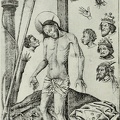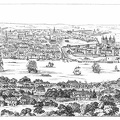Size of the original engraving, 5⅞ × 5¼ inches
In the Royal Print Room, Dresden
The technical method of the Master of the Playing Cards is that of a painter rather than of a goldsmith. There is practically no cross-hatching, and the effect is produced by a series of delicate lines, mostly vertical, laid close together. His plates are unsigned and undated, so that we can only approximate the period of his activity. That he preceded, by at least ten years, the earliest dated engraving, the Flagellation, by the Master of 1446, may safely be assumed, since in the manuscript copy of Conrad von Würzburg’s “The Trojan War,” transcribed in 1441 by Heinrich von Steinfurt (an ecclesiastic of Osnabrück), there are pen drawings of figures wearing costumes which correspond exactly with those in prints by the Master of the Playing Cards in his middle period. The Master of the Playing Cards is, therefore, the first bright morning star of engraving. From him there flows a stream of influence affecting substantially all of the German masters until the time of Martin Schongauer, some of whose earlier plates show unmistakable traces of an acquaintanceship with his work.
St. George and the Dragon is in his early manner. Here are plainly to be seen the characteristics of this first period—the broken, stratified rocks, the isolated and conventionalized plants, and the peculiar drawing of the horse, especially its slanting and half-human eyes. The Playing Cards, from which he takes his name, may safely be assigned to his middle period.
- Author
- Engravers and Etchers
Six Lectures Delivered on the Scammon Foundation at the Art Institute of Chicago, March 1916
By Fitzroy Carrington
1917
Available from gutenberg.org - Posted on
- Wednesday 1 December 2021
- Dimensions
- 800*884
- Tags
- Century:15th, Dragon, Fine Art
- Visits
- 1113
- Downloads
- 31
 Download Photo
Download Photo





